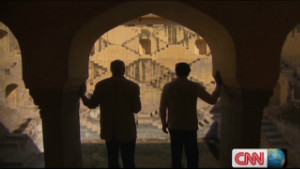Hawaiians use Lanai style buildings to keep cool. I saw a building built in this style in a very hot part of California. It worked well there also.
Here is a quote about how the Hawaiian cooling architecture works:
"A traditional 'Tropical 3 Pitch Roof'' design features a shaded lanai facing South, which produces a cool ground. Then convection draws the hot air out of the peaked roof and brings the cooler air into the living spaces. HPA’s Energy Lab building resonates with the Tropical 3 Pitch Roof design. The mauka (mountainside) winds travel over the roof creating an augmented vacuum. This vacuum in the broken peak is even more effective than the original 3 pitch roof design."
The quote is from the energy lab at Hawaiian Preparatory Academy. Here is a link (There are pictures.) :
http://www.hpa.edu/academics/energy-lab/about-lab
Here is a traditional approach to cooling from India:
"Award-winning architect
Manit Rastogi, who designed the academy, explains that baoli -- the
Hindi word for stepwell -- are bodies of water encased by a descending
set of steps.
 Green lessons from Mughal architecture
Green lessons from Mughal architecture
"When water evaporates in heat, it immediately brings down the temperature of the space around it," he says."
This quote comes from this site:
The quote below comes from the same source.
"Centuries ago, latticed screens or "jaali" filtered direct sunlight into the palaces. The effect was decorative and helped reduce the heat."
Here is a quote from a site about traditional Iranian desert architecture:
"The buildings in the Iranian desert regions are constructed according to the specific climatic conditions and differ with those built in other climates. The desert buildings are equipped with air traps, arched roofed, water reservoirs with arched domes and ice stores for the preservation of ice. The operation of modern coolers is similar to the old Iranian air traps which were built at the entrance of the house over underground water reservoirs or ponds built inside the house."
Here is the site it comes from:
http://www.cais-soas.com/CAIS/Architecture/wind.htm
There is an excellent 12 page PDF that covers the basics about how you can save up to 88% on energy cost by the choices you make when building a new structure. The decisions are divided into three tiers.
The first tier is architecture itself. They assert that you can save 60% of future power use in the building by architectural choices to do with heating, cooling, and lighting.
The second tier is natural systems such as passive heating, cooling and daylighting systems. They say you can save another 20% of future energy costs in this stage.
The third tier is engineering, or design of mechanical equipment used in the building. The authors say you can save an additional 8% of future power needs in this stage.
There is a nice graphic of how this works and what is involved on page 9 of the PDF. It can be found here: http://media.wiley.com/product_data/excerpt/93/04700480/0470048093.pdf
It is suggested that the remaining 12% of normal energy needs can be easily met by use of renewable and local energy sources. I think this information is necessary to consider for people to have a chance to have a good life. That makes it disaster preparedness and risk reduction.
We do not need to waste world energy resources the way we are doing now. It is possible to be comfortable, happy and healthy with much less energy use than we use now. I hope you will think about this and pass it on and put it to use.
"Centuries ago, latticed screens or "jaali" filtered direct sunlight into the palaces. The effect was decorative and helped reduce the heat."
Here is a quote from a site about traditional Iranian desert architecture:
"The buildings in the Iranian desert regions are constructed according to the specific climatic conditions and differ with those built in other climates. The desert buildings are equipped with air traps, arched roofed, water reservoirs with arched domes and ice stores for the preservation of ice. The operation of modern coolers is similar to the old Iranian air traps which were built at the entrance of the house over underground water reservoirs or ponds built inside the house."
Here is the site it comes from:
http://www.cais-soas.com/CAIS/Architecture/wind.htm
There is an excellent 12 page PDF that covers the basics about how you can save up to 88% on energy cost by the choices you make when building a new structure. The decisions are divided into three tiers.
The first tier is architecture itself. They assert that you can save 60% of future power use in the building by architectural choices to do with heating, cooling, and lighting.
The second tier is natural systems such as passive heating, cooling and daylighting systems. They say you can save another 20% of future energy costs in this stage.
The third tier is engineering, or design of mechanical equipment used in the building. The authors say you can save an additional 8% of future power needs in this stage.
There is a nice graphic of how this works and what is involved on page 9 of the PDF. It can be found here: http://media.wiley.com/product_data/excerpt/93/04700480/0470048093.pdf
It is suggested that the remaining 12% of normal energy needs can be easily met by use of renewable and local energy sources. I think this information is necessary to consider for people to have a chance to have a good life. That makes it disaster preparedness and risk reduction.
We do not need to waste world energy resources the way we are doing now. It is possible to be comfortable, happy and healthy with much less energy use than we use now. I hope you will think about this and pass it on and put it to use.
No comments:
Post a Comment